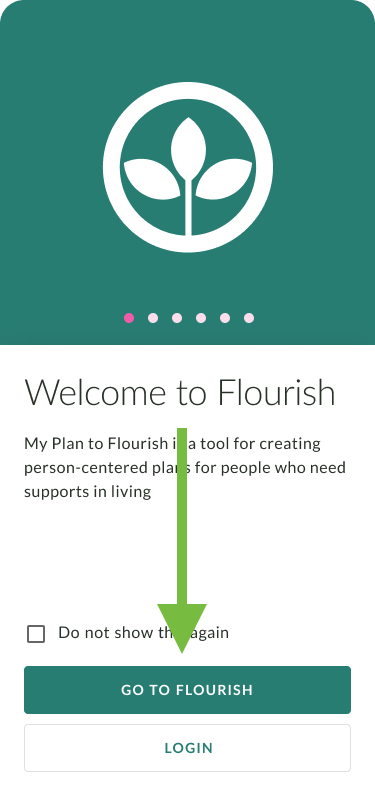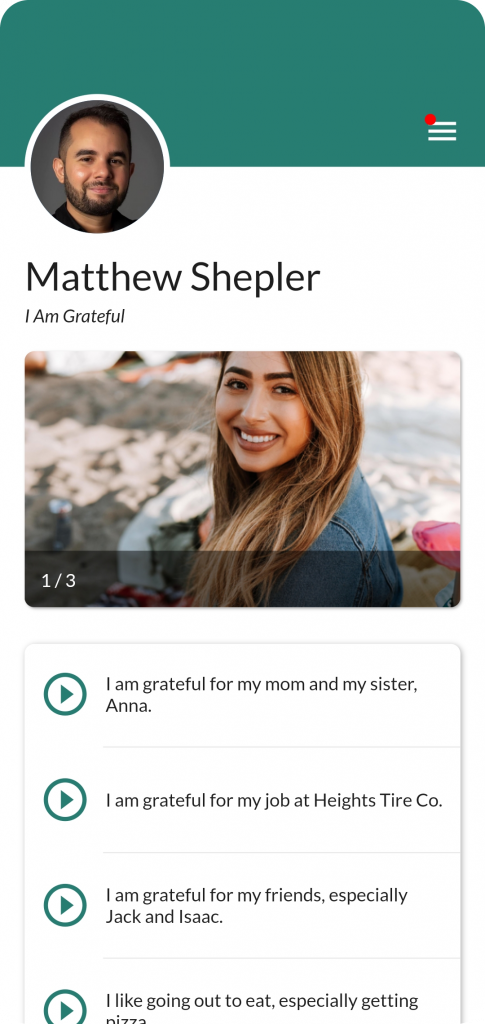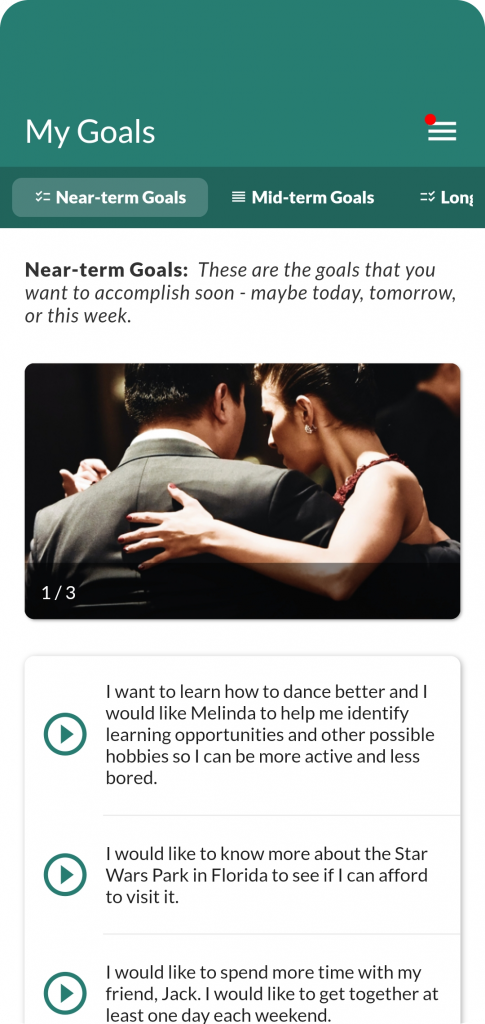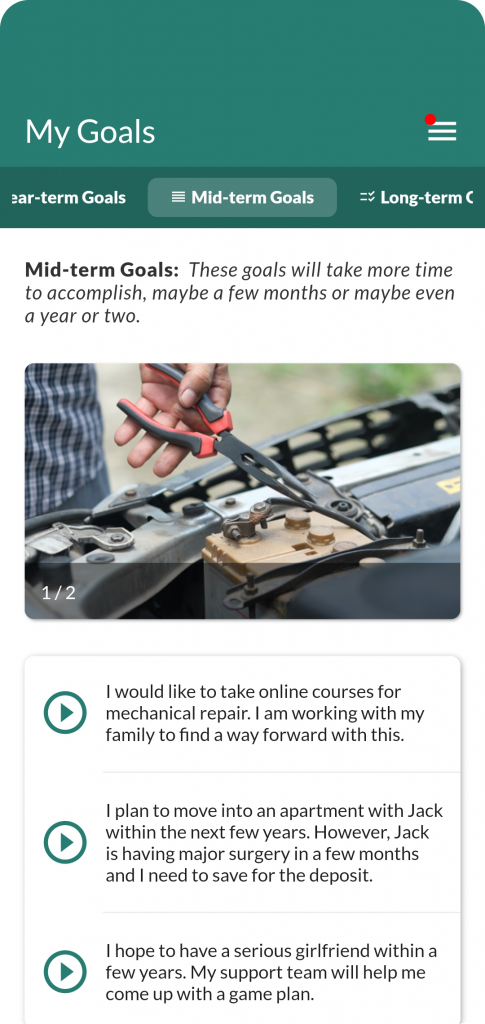How Can We Help?
Flourish 2.0 App Quick Start Guide
This article will help you get started with administering and using Flourish 2.0’s simplified mobile person-centered plan.
Getting Flourish
Download the Flourish app from the Apple App Store or Google Play Store, or contact for a device loaded with the Flourish app.
Using Flourish for the First Time
Open Flourish on your device
Press the “Go to Flourish” button

If you are using the cloud-enabled version of Flourish for care professionals, press login and enter the Flourish ID of the person you’re supporting.
Onboarding
Onboarding is the process of getting the person you serve ready to use the Flourish app.
Begin onboarding the Flourish app by filling out the forms:
My Cover Page

This page is for communicating the person’s personality in terms of interest and experiences.
Here, you can place a high-quality picture or selfie of the person that shows them in a setting of their choice. It’s best not to use a photo that looks like a “mugshot.”
Name:
Enter the person’s preferred name here.
The Importance of Gratitude:
Sharing experiences of gratitude helps introduce the person to others in a very positive way.
A spirit of gratitude leads to positive emotions.
A spirit of gratitude creates positive relationships.
Gratitude makes life more satisfying and allows people to share and remember positive thoughts and experiences.
Here are some examples of positive statements of gratitude:
“I am grateful for my Mom, Dad, and Ellen, my sister.”
“I am grateful for my job.”
“I am grateful for my friends.”
I Am Proud Of
On this panel, feel free to share things the person is proud of owning, things they have recently accomplished or tried as well as any new changes in their life.
It’s OK to boast a little bit.
Here are some example statements:
“I have a new job.”
“I am going to a new church.”
“I joined the Model Railroad Club.”
Keys to Coaching Me
This section is for sharing information with the people who are working closely with the person to provide the supports that they may need or desire.
Share what works best for the person when they’re having a rough day — words of encouragement, knowing why something should be done, helping change their focus, how best to help when they’re angry or upset, etc.
Also, share different ways the person calms themself down if they get upset — going to their room, going for a walk or listening to music are some examples. If certain words or topics are “hot buttons” for the person, share that as well.
My Wellness
This page is for communicating the person’s personality in terms of interest and experiences.
Here, you can place a high-quality picture or selfie of the person that shows them in a setting of their choice. It’s best not to use a photo that looks like a “mugshot.”
Name:
Enter the person’s preferred name here.
The Importance of Gratitude:
Sharing experiences of gratitude helps introduce the person to others in a very positive way.
A spirit of gratitude leads to positive emotions.
A spirit of gratitude creates positive relationships.
Gratitude makes life more satisfying and allows people to share and remember positive thoughts and experiences.
Here are some examples of positive statements of gratitude:
“I am grateful for my Mom, Dad, and Ellen, my sister.”
“I am grateful for my job.”
“I am grateful for my friends.”
My Interests
This is for sharing things or items that engage the person’s attention, including things they like to do.
This section can often be lengthy, which is a good thing.
As a result, bullet points can be used.
This list may include the person’s hobbies, church attendance, sports teams, physical exercise, such as “riding my bike,” certain TV programs, and favorite restaurants, among many possibilities.
Here are some example statements:
“Building Lego kits.”
“Going out to eat.”
“Riding my bicycle.”
My Priorities
It will help to do this with the person you are creating a plan for
Press the informational icon if you would like more context or clarification about a particular concept.
Developing Goals
Flourish lets you set goals in four specific areas:
Near-term—goals that you believe you can accomplish in the next year
Mid-term—Goals you believe may take two to four years to accomplish
Long-term—Goals you feel may take more than 4 years to accomplish
These time periods are the dates you are setting for the person to accomplish their goals. This isn’t concrete but will be useful to the person as a planning guide.
The “Goals Suggested by Others” page does not follow a timeline but rather includes goals suggested by other people in the life of the person served.
It helps if the person can be specific about their goals to tell if they are making progress towards them or have accomplished them. A goal such as ‘I’d like to lift weights’ could include information about frequency (I’d like to lift weights twice a week) if this is important to the person.
If setting personal goals is new to the person or if they find it difficult to work on or follow up on your goals, it may be best to begin with fewer goals rather than developing too many.
Near-Term Goals

In this first goal area, the time frame to consider is short-term—from the day we write them down to up to one year. Hopefully, the person will accomplish many of their Near-Term goals sooner than a year. As a result, the person may be developing more near-term goals than those that take longer.
Remember, you may need to break down some goals into steps. Think about a carpenter—he must first build walls before he can put on the roof.
Some examples:
‘I would like to spend more time with Bob and Jim playing video games—at least one day every weekend.’
‘I want to play a musical instrument, maybe a guitar, but I’m not sure.’
‘It would be great if I could visit my grandparents in Indiana.’
‘I would like to have some money so I could buy my sister a Christmas present.’
Mid-Term Goals

This goal time period is from about 2 years to 4 years. This area of your ‘My Plan to Flourish’ may be the most difficult to set in terms of selecting an exact time. There are many reasons why—this time frame may involve learning a new skill, changing your mind, saving money or having unexpected things happen.
Again, it is quite likely that the goals identified in this section will need to be broken down into steps and that you may need some assistance to accomplish the goal.
Some examples:
‘I would like to have a steady girlfriend that I can go on dates with.’
‘I could do more things if | learned how to take the bus downtown or to Wal-Mart.’
Long-Term Goals
Think about this time frame as requiring more than four years. These are the hopes and dreams the person has for their life. Ideas may vary over time but could involve friends and relationships, work or career goals, where they live, taking classes, learning a new hobby, completing a training program, or even planning for retirement.
Most of us change or modify our dreams for the future because we have gained new information, perhaps have developed a physical limitation or experience a lack of sufficient resources.
It is important to have long-term goals because it allows us to view the future positively and think not only about the present, but how we would like things years from now.
Some examples:
‘I would like to have a job as a car mechanic in the future.’
‘It would be nice if I could live someplace where it was warm in the winter, maybe with a close friend.’
‘I would like to go to NASCAR races whenever I want to.’
Goals Recommended By Others
In the last goal area of Flourish, we identify the goals recommended by others. Such goal recommendations may come from our friends, parents, support staff and, many times, from our doctors.
Some examples:
‘After talking with my doctor, I agree that I should go for a walk every day to help lose some weight.’
‘I know sometimes | get too angry. I will work on following the anger management program that | have and go a month without breaking any objects.’
‘I am willing to go to the dentist if I can meet her first and see if I like her.’
Editing Flourish Pages
Open the menu in Flourish and press the gear icon for 5 seconds, then pick what part of the plan you’d like to edit and press the edit button.